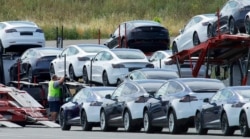After a year of unprecedented decline from COVID-19, emissions of planet-warming greenhouse gases are nearly back to where they were before the pandemic, according to new research.
Though most countries have missed an opportunity to promote clean energy in the trillions of dollars they spent stimulating their economies, experts say some of the positive trends in emissions may last anyway.
The world added about 2 billion fewer metric tons of carbon dioxide to the atmosphere in 2020 than in 2019, a 5.4% decline, according to the study awaiting review by outside experts.
That is the largest percentage decline since World War II, and the largest drop ever in absolute terms.
But it is nothing to celebrate, said Rob Jackson, chair of the steering committee of the Global Carbon Project, a group that tracks global emissions.
"We can't cut emissions by putting hundreds of millions of people out of work and locking everyone at home," he said.
About half of the decline came from transportation. People simply stopped driving and flying. Ground transportation alone accounted for nearly half of the total drop in emissions. Aviation was a smaller slice of the pie but saw the largest percentage decline. Flights were down by half for the year.
But by December, global emissions were about back to normal.
Some estimates predict greenhouse gas production will increase again this year. The question is whether it returns to pre-pandemic levels.
"Was [2019] the year of peak fossil carbon emissions? I don't think so," Jackson said. "But it's possible."
'Remarkable year' for clean energy
Some trends make others more optimistic.
"2020 was an absolutely remarkable year" for clean energy, said Ethan Zindler, head of Americas for BloombergNEF, an energy research firm.
Record amounts of renewable energy were installed worldwide, despite the pandemic. New wind and solar capacity grew by roughly a third last year, according to BloombergNEF data, results that came as somewhat of a surprise.
"Things definitely did not look great around April or May," Zindler said. Supply chains were broken. Installers could not get into people's homes to put solar panels on their roofs.
But a few factors made for an outstanding year, he said.
In the United States, developers looked to cash in on tax credits that were expected to retire, though Congress ultimately extended them.
Even without subsidies, however, the cost of renewable energy has fallen dramatically in the last decade.
"Not only are they safer and cleaner than the fossils, they're simply cheaper nowadays, too," Jackson said.
Electric vehicles also had a good year. Though they remain a paltry 4.4% of the overall auto market, EV sales grew from 2 million in 2019 to 3 million last year, according to the International Energy Agency.
The growth came during a bad year for the auto industry as a whole. Conventional auto sales were down by 15% compared to 2019, while EV sales grew by 46%.
Europe overtook China as the world's largest EV market, thanks in large part to new government incentives.
Lost opportunity?
With emissions way down, many experts see recovery from the COVID-19 pandemic as an opportunity to change the trajectory on climate change. Many countries have approved generous stimulus plans to counteract the devastating economic impact of the COVID-19 pandemic.
But of the trillions of dollars committed, less than $1 trillion is dedicated to reducing emissions, while more than $1 trillion has gone to support fossil fuel-intensive industries such as aviation, according to research by BloombergNEF.
The world is far off its climate targets and needs to make dramatic emissions cuts in order to ward off a catastrophic increase in global temperatures.
Clean energy is growing and emissions are declining, but "we definitely don't see them declining anywhere near fast enough under current policies to get you anywhere close" to climate targets, Zindler said.
With less traffic on the roads, COVID-19 lockdowns cleaned the air in many places. Estimates of lives saved from reduced air pollution are in the tens of thousands.
The lockdowns were not the way to cut emissions, Jackson said. But they demonstrate what other benefits would come from reducing fossil fuel emissions.
"If we can do that, we should be in much better shape," he said.















